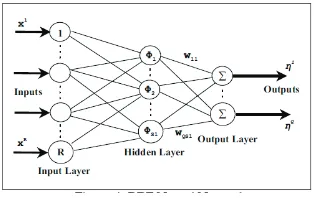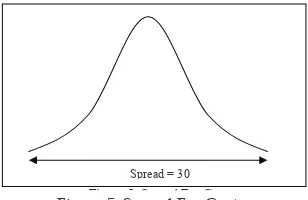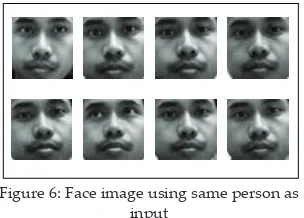ISSN: 2180 - 1843 Vol. 3 No. 2 July-December 2011
Face Recognition Using Fixed Spread Radial Basis Function Neural Network For Security System
55
Abstract
This paper presents face recognition using
spread ixed spread radial basis function
neural network for security system. The face
recognition system can be applied to security
system such as door lock system etc. Acquired
image will be going through image processing
process. General preprocessing approach is use for normalizing the image. Radial Basis Function Neural Network is use for face recognition and Support Vector Machine is used as the face detector. RBF Neural Networks
ofer several advantages compared to other neural network architecture such as they can be
trained using fast two stages training algorithm
and the network possesses the property of best
approximation. The output of the network can
be optimized by seting suitable values of the center and spread of the RBF but in this paper ixed spread is used as there is only one train image for every user and to limit the output value.
Keywords: component; Face recognition, Radial Basis Function Neural Network, Image Processing.
I. INTRODUCTION
Biometrics deals with the identiication
of individuals based on their biological
FaCe ReCOgNITION UsINg FIxeD spReaD RaDIal BasIs
FUNCTION NeURal NeTwORk FOR seCURITy sysTem
Khairul Azha A. Aziz, Rostam Afendi Hamzah, Shahrum Shah Abdullah,
Ahmad Nizam Jahari, Siti Dhamirah ‘Izzati Damni
1
Universiti Teknikal Malaysia Melaka (UTeM)
Faculty of Engineering Technology
Malacca, Malaysia
2
Universiti Teknologi Malaysia (UTM)
Malaysia - Japan International Institute of Technology (MJIIT)
Kuala Lumpur, Malaysia
Universiti Teknikal Malaysia Melaka (UTeM)
Faculty of Electronics and Computer Engineering
Malacca, Malaysia
Email: [email protected], [email protected],
or behavioral characteristics [1]. Face
can be deined as the front part of
head from the forehead to the chin [2]. A number of biometrics have been proposed, researched and evaluated for
identiication applications. Face is one of
the most acceptable biometrics because it is one of the most common methods of
identiication which humans use in their
interactions [1]. Face recognition is one of many possible approaches to biometric
identiication therefore many biometric
systems are based on face recognition in combination with other biometric
features such as voice or ingerprints. The
human face is a dynamic object but with
a standard coniguration of facial features
which can vary within a limited range such as using only the frontal view. It is a
diicult problem to detect such dynamic
ISSN: 2180 - 1843 Vol. 3 No. 2 July-December 2011 Journal of Telecommunication, Electronic and Computer Engineering
56
II. Image pROCessINg
In this project, the acquired image is irst
converted into double class in matrix form. The matrix is then converted into column matrix 1 x n. This input will be fed into the RBF network for the next process. Figure 1 and 2 shows the conversion of image into matrix form. The image that to be fed into the network whether for training or testing will be normalized using a preprocessing step, adapted from [4].
s
viduals cs [1]. the cs have been
tification etrics thods of
s [1]. ny possible approaches to stems ination with other s. The human rd configuration of
ch as Figure 1: Convert Image to Matrix Matrix
Form Grayscale
Image
Figure 1: Convert Image to Matrix
Figure 2: Convert Matrix to Column Matrix
Η
∑
= − = φ η ℜ ∈ φ ℜ ∈ φ η = − − = φ φφ KK
K =
β
φ = − β Matrix Form Column Matrix
Form
Figure 2: Convert Matrix to Column Matrix
Acquired Image Preprocessing Image Figure 3: Image Preprocessing
Η
∑
= − = φ η ℜ ∈ φ ℜ ∈ φ η = − − =φ φφ KK
K =
β
φ = − β Figure 3: Image Preprocessing
III. RaDIal BasIs FUNCTION
NeURal NeTwORk
RBFNN ofers several advantages
compared to the Multilayer Perceptrons. Two of these advantages are:
1. They can be trained using fast 2 stages training algorithm without the need for time consuming non-linear optimization techniques.
2. ANN RBF possesses the property of ‘best approximation’ [11]. This means that if in the set A of approximating functions (for instance the set F(x, w) spanned by parameters w), then the RBFNN has the minimum distance from any given function of a larger set, H.
RBFNN had been successfully used in face detection such as in Mikami, et.al., 2003[3] and K. A. A. Aziz, et.al. [12][13] [14]. Figure 4 illustrates the architecture of the RBFNN used in this work.
Η
Figure 4: RBF Neural Network
∑
= − = φ η ℜ ∈ φ ℜ ∈ φ η = − − = φ φφ KK
K =
β
φ = − β
Figure 4: RBF Neural Network The network consists of three layers: an input layer, a hidden layer and an output layer. Here, R denotes the number of inputs while Q the number of outputs.
For Q = 1, the output of the RBFNN in
Figure 4 is calculated according to
∑
= −= 1
1 1 (|| ||)2
) ,
(x w Sk wkφ x ck
η
1 Rx
x∈ℜ φ
ℜ ∈ φ η = − − = φ φ
φ KK
K = β φ = − β
∑
= − = φη (1)
ℜ ∈ φ(.) ℜ ∈ φ η = − − = φ φ
φ KK
K
=
β
φ = −
β
where x∈ℜRx1is an input vector, φ(.) is a basis function, ||.|| denotes the Euclidean norm, w1k are the weights
in the output layer, S1 is the number of neurons (and centers) in the hidden
layer and
1 Rx k
c ∈ℜ
are the RBF centers in the input vector space. Equation (1) can
ISSN: 2180 - 1843 Vol. 3 No. 2 July-December 2011
Face Recognition Using Fixed Spread Radial Basis Function Neural Network For Security System
57 Η
∑
= − = φ η ℜ ∈ φ ℜ ∈ w x w x T ) ( ) , ( φ η = where − − = φ φφ KK
K = β φ = − β Η
∑
= − = φ η ℜ ∈ φ ℜ ∈ φη = (2)
− −
= φ φ
φ KK
K = β φ = − β where age Η
∑
= − = φ η ℜ ∈ φ ℜ ∈ φ η = ||)] (|| ||) (|| [ )( 1 S1 S1
T
c x c
x
x = φ − φ −
φ KK
and K = β φ = − β Η
∑
= − = φ η ℜ ∈ φ ℜ ∈ φ η = ||)] − − = φ φφ KK (3)
K = β φ = − β and
ared to the
aining Η
∑
= − = φ η ℜ ∈ φ ℜ ∈ φ η = − − = φ φφ KK
] [ 11 12 1S1
T
w w w
w = K
The output of the neuron in
β φ = − β Η
∑
= − = φ η ℜ ∈ φ ℜ ∈ φ η = − − = φ φφ KK
K
= (4)
dden layer is a nonlinear
β
φ = −
β
The output of the neuron in a hidden layer is a nonlinear function of the distance given by:
‘best e set of
F(x, w) s the Η
∑
= − = φ η ℜ ∈ φ ℜ ∈ φ η = − − = φ φφ KK
K = 2 2 ) ( β φ x e x − =
β is the spread p
Η
∑
= − = φ η ℜ ∈ φ ℜ ∈ φ η = − − = φ φφ KK
K
=
β
φ = − (5)
β . For training, the
β is the spread parameter of the RBF. For
training, the least squares formula was
used to ind the second layer weights
while the centers are set using the available data samples.
IV. NeTwORk TRaININg
The network is trained using one image for every user. The simplest procedure for selecting the basis function centers ck is to set the center equal to the input vectors or a random subset of the input vectors from the training set but this is not an optimal procedure since it leads to the use of unnecessarily large number of basis function [6]. Broomhead et.al. [8] suggested strategies for selecting RBF centers randomly from the training data. The centers of RBF can either be distributed uniformly within the region of input space for which there is data. In this paper K-means clustering was used.
K-means clustering is one of the
techniques that was used to ind a set
of centers where the technique is more
accurately relects the distribution of the
data points [6]. It is used in research such as in [3] and [7]. In k-means clustering, the number of desired centers, K, must
be decided in advance. The diference
between two n-dimensional vectors, Vi
and Vj will be the spread value given by:
}
{
∑
= ⋅ −= n
k k ik jk
ij w v v
E 1 2 ) (
For the training, supervised learning i
p
}
{
∑
= ⋅ − = (6)is used where
p
For the training, supervised learning
is used where training paterns are
provided to the RBFNN together with a teaching signal or target. As for the input of the user’s face will be given the value of 1.
V. TesTINg
Testing the network divided into two
parts. The irst part is using the same
person as the input image and the second
part is using diferent person. For both
part, the output values are recorded.
}
{
∑
= ⋅ −=
Figure 5: Face detection
p
Figure 5: Face detection
Face detection use the new reduced set method for Support Vector Machines (SVMs) taken from [9].
}
{
∑
= ⋅ −=
Figure 5: Spread For Center
Spread = 30
Figure 5: Spread For Center
In this paper, ixed spread value of
RBFNN is used and spread ranging from
Journal of Telecommunication, Electronic and Computer Engineering
ors,
}
{
∑
= ⋅ −=
ere th a the input of the user’s face
Figure 6: Face image using same person as input
p
Figure 6: Face image using same person as input
VI. ResUlTs aND DIsCUssIONs
Table 1 shows the output using 10 images with spread ranging from 10 to 30.
Table 1: Output using diferent spread value
}
{
∑
= ⋅ − =thod for
Table 1: Output using different spread value
Image No. Spread Value
10 15 20 25 30
1 0.12177 0.47407 0.65204 0.76677 0.86208
2 0.09497 0.46838 0.62428 0.74399 0.81019
3 0.15841 0.44032 0.62468 0.72568 0.80599
4 0.37757 0.42894 0.62910 0.76942 0.79489
5 0.30389 0.46488 0.61575 0.73994 0.79581
6 0.38865 0.43339 0.64862 0.73414 0.80894
7 0.29739 0.46123 0.63516 0.82496 0.79308
8 0.40463 0.46402 0.59523 0.83513 0.80746
9 0.35306 0.42466 0.60791 0.70033 0.78928
10 0.36185 0.45722 0.74761 0.74080 0.77571
p
The results of testing the face recognition system using RBFNN are shown in Table
2 and Table 3. The RBFNN used ixed spread seting that is equal to 30. As for
the face detection, SVM from [14] was
used. The irst image in Table 2 is the
training image for the RBFNN and the target value is 1. As we can see in the table, the values for imposter or other than the user were less than 0.8. Table 3 is the result of testing the system using only the user’s face as the input. Here we can see that values given by the network are more than 0.85.
Table 2: Testing using diferent person image as input
Table 2: Testing using different person image as input Acquired
Image
Preprocessing Image
Value
(Training Image)
0.8603 (user)
0.6421
0.7232
0.7827
recog for im b syste m f Inst be en recognition
Sh
Table 3: Testing using user image as inputTable 3: Testing using user image as input Acquired
Image
Preprocessing Image
Value
(Training Image)
0.9155 (recognize)
0.8966 (recognize)
0.8921 (recognize)
0.8542 (recognize)
VII. CONClUsION
ISSN: 2180 - 1843 Vol. 3 No. 2 July-December 2011
Face Recognition Using Fixed Spread Radial Basis Function Neural Network For Security System
59
aCkNOwleDgmeNT
The authors would like to acknowledge the funding from Short Term Grant of Universiti Teknikal Malaysia Melaka.
ReFeReNCes
[1] A. Jain, R. Bolle, and S. Pankanti, “Biometrics: Personal Identifucation in Networked Society”, Springer Science+Business Media, Inc 2006. [2] A. G. Bors, “Introduction of Radial
Basis Functions (RBF) Networks”, University of York.
[3] T. Mikami, M. Wada, “Example-based Face Detection Using Independent Component Analysis and RBF Network”, SICE Annual Conference in Fukui, August 4-6, 2003.
[4] H. A. Rowley, S. Baluja, and T. Kanade. “Neural Network-Based Face Detection”, IEEE Trans. Patern Analysis and Machine Intelligence, vol. 20, no. 1, pp. 23-38. 1998.
[5] T. Dunstone and N. Yager, “Biometric System and Data Analysis”, Springer 2008.
[6] S. S. Abdullah, M. M. Idris, “A Short Course In Artiicial Neural Networks” 2008.
[7] M. J. Er, S. Wu, J. Lu, and H. L. Toh, Face Recognition With Radial Basis Function (RBF) Neural Networks, IEEE Transactions On Neural Networks, Vol. 13, No. 3, May 2002.
[8] D. S. Broomhead and D. Lowe, Multivariable functional interpolation and adaptive networks, Complex Systems, vol. 2, pp 321-355.
[9] E. Hjelmas, and B. K. Low, “Face Detection: A Survey” Academic Press, 2001.
[10] W. Kienzle, G. Bakir, M. Franz and B. Scholkopf: Face Detection - Eicient and Rank Deicient. In: Advances in Neural Information Processing Systems 17, pg. 673-680, 2005.
[11] F. Girosi and T. Poggio 1990, “Networks and the best approximation property”. Boilogical Cybernetics 63, 169-176.
[12] K. A. A. Aziz and S. S. Abdullah. “Face Detection Using Radial Basis Functions Neural Networks With Fixed Spread”, The Second International Conference on Control, Instrumentation and Mechatronic Engineering (CIM09) Malacca, Malaysia, June 2-3, 2009. [13] K. A. A. Aziz, S. S. Abdullah, R..
A. Ramlee and A. N. Jahari. “Face Detection Using Radial Basis Function Neural Networks With Variance Spread Value”, The International Conference of Sot Computing and Patern Recognition (SoCPaR 2009) Malacca, Malaysia, December 4-7, 2009. [14] K. A. A. Aziz, S. S. Abdullah, R. A.
Ramlee, S. I. Samsudin and A. N. Jahari “Overlapping Factor For Radial Basis Function Neural Network Spread Value In Face Detection”, The 2nd International Conference


